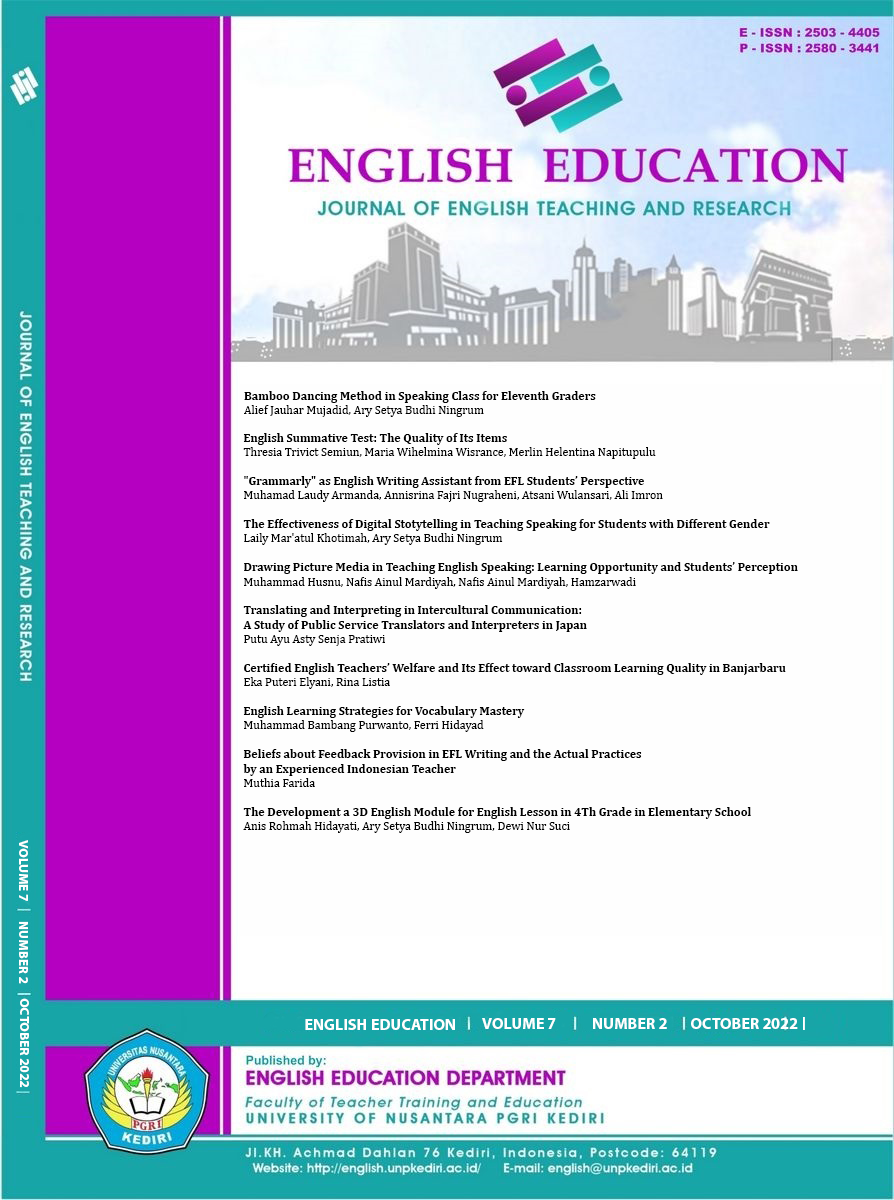"Grammarly" as English Writing Assistant from EFL Students’ Perspective
DOI:
https://doi.org/10.29407/jetar.v7i2.17988Keywords:
Grammarly, Online Grammar Checker, Writing Process, EFL Students’ PerspectiveAbstract
Automated Writing Evaluation (AWE) has been regarded as a viable pedagogical approach that utilizes technology to assist EFL students' writing. Writing becomes one of the important skills in English at any proficiency level. Hence, this study aimed to determine what EFL students thought about using Grammarly to check their work for grammar errors. Moreover, this research also describes the students’ frequency in using Grammarly to improve their writing. This study used descriptive qualitative methods to explore the students’ perspective in using Grammarly to check their work for grammar when writing articles. In addition, this study used non-probability sampling employing a purposive sampling technique. To assess the perception, researchers tracked 40 EFL students using a close-ended questionnaire with five indicators of Likert scale. At the same time, interviews were used as data triangulation. According to the results, most EFL students have a favorable view of utilizing Grammarly as an online grammar checker to assist them in writing articles. As an English writing helper, evidence showed that Grammarly could check for grammatical and stylistic errors. This study has thus far shed light on the good and bad aspects of utilizing Grammarly among EFL students. In general, EFL students think Grammarly's capabilities help write an article.
Downloads
References
Chen, C. F. E., & Cheng, W. Y. E. (2008). Beyond the design of automated writing evaluation: Pedagogical practices and perceived learning effectiveness in EFL writing classes. Language Learning & Technology, 12(2), 94-112.
Fahmi, M. A., & Cahyono, B. Y. (2021). EFL students’ perception on the use of Grammarly and teacher feedback. Journal of English Educators Society, 6(1), 18–25. https://doi.org/10.21070/jees.v6i1.849
Ferster, B., Hammond, T. C., Alexander, C., & Lyman, H. (2012). Automated formative assessment as a tool to scaffold student documentary writing. Journal of Interactive Learning Research, 23(1), 21-39.
Fitriana, K., & Nurazni, L. (2021) Exploring English Department Students’ Perceptions on Using Grammarly to Check the Grammar in their Writing. Journal of English Teaching, 8(1), 15-25. https://doi.org/10.33541/jet.v8i1.3044
Miranty, D., & Widiati, U. (2021). An automated writing evaluation (AWE) in Higher Education: Indonesian EFL Students’ Perceptions about Grammarly Use across Student Cohorts. Pegem Journal of Education and Instruction, 11(4), 126–137. https://doi.org/10.47750/pegegog.11.04.12
Perdana, I., & Farida, M. (2019). Online Grammar Checkers and Their Use for EFL Writing. Journal of English Teaching, Applied Linguistics, and Literatures, 2(2), 67–76. https://doi.org/10.20527/jetall.v2i2.7332
Pratama, Y. D. (2020). The Investigation of Using Grammarly as Online Grammar Checker in the Process of Writing. English Ideas: Journal of English Language Education, 1(1), 46–54.
Smith, F. (2013). Writing and the Writer. Routledge.
Wilson, J., & Andrada, G. N. (2016). Using automated feedback to improve writing quality: opportunities and challenges. In Y. Rosen, S. Ferrara & M. Mosharraf (Eds,), Handbook of research on technology tools for real-worldskill development (pp. 678-703). IGI Global: US. doi: 10.4018/978-1-4666-9441-5.ch026
Wilson, J., & Czik, A. (2016). Automated essay evaluation software in English language arts classrooms: Effects on teacher feedback, student motivation, and writing quality. Computers & Education, 100, 94-109. https://doi.org/10.1016/j.compedu.2016.05.004
Mammadova, T. (2019). Teaching Grammar to a Grammar-Free Generation. Cambridge Scholars Publishing.
Downloads
Published
Issue
Section
License
Authors who publish with this journal agree to the following terms:
- Copyright on any article is retained by the author(s).
- The author grants the journal, the right of first publication with the work simultaneously licensed under a Creative Commons Attribution License that allows others to share the work with an acknowledgment of the work’s authorship and initial publication in this journal.
- Authors are able to enter into separate, additional contractual arrangements for the non-exclusive distribution of the journal’s published version of the work (e.g., post it to an institutional repository or publish it in a book), with an acknowledgment of its initial publication in this journal.
- Authors are permitted and encouraged to post their work online (e.g., in institutional repositories or on their website) prior to and during the submission process, as it can lead to productive exchanges, as well as earlier and greater citation of published work.
- The article and any associated published material is distributed under the Creative Commons Attribution-ShareAlike 4.0 International License








 Article template
Article template



